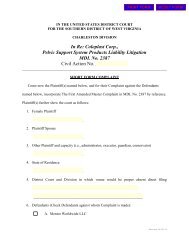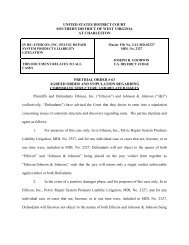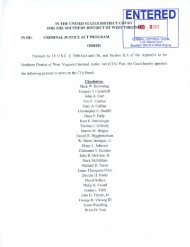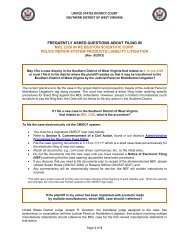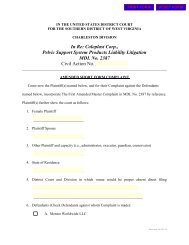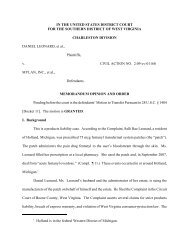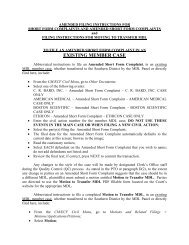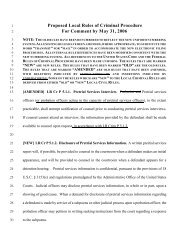R:\Storage\AE\Chapman, Ronald (C)\Order denying motion to ...
R:\Storage\AE\Chapman, Ronald (C)\Order denying motion to ...
R:\Storage\AE\Chapman, Ronald (C)\Order denying motion to ...
You also want an ePaper? Increase the reach of your titles
YUMPU automatically turns print PDFs into web optimized ePapers that Google loves.
IN THE UNITED STATES DISTRICT COURT FORTHE SOUTHERN DISTRICT OF WEST VIRGINIAHUNTINGTON DIVISIONUNITED STATES OF AMERICAv. CRIMINAL ACTION NO. 3:10-00034RONALD MARK CHAPMANMEMORANDUM OPINION AND ORDERPending is the defendant’s Motion <strong>to</strong> Dismiss (Doc. 38). For the reasons explained below,the Court DENIES the <strong>motion</strong>.BackgroundOn February 17, 2010, a grand jury sitting in the Southern District of West Virginia returneda single count indictment against the defendant, charging him with a violation of 18 U.S.C. §922(g)(8) and 924(a)(2). The indictment alleges that on or about December 28, 2009, at or nearMil<strong>to</strong>n, West Virginia, the defendant knowingly possessed six firearms and approximately 941rounds of ammunition, in and affecting interstate commerce. At the time the defendant possessedthe firearms and ammunition he was subject <strong>to</strong> a Domestic Violence Protection Order (“DVPO”)which was issued after a hearing of which the defendant received actual notice, and at which thedefendant had an opportunity <strong>to</strong> participate.Prior <strong>to</strong> Oc<strong>to</strong>ber 2009, the defendant was in a romantic relationship with the victim. Thisrelationship lasted approximately three-and-a-half years. During this period of time, the defendant
frequently stayed overnight at the victim’s residence, kept a <strong>to</strong>othbrush and clothing there, and thetwo vacationed <strong>to</strong>gether.In Oc<strong>to</strong>ber 2009, the victim informed the defendant that she wanted <strong>to</strong> end the relationship.Shortly thereafter, the defendant began <strong>to</strong> stalk the victim. She contacted the police on Oc<strong>to</strong>ber 16,2009, <strong>to</strong> have him removed from her residence. Within days, he was spotted by neighbors outsidethe victim’s new boyfriend’s residence in South Charles<strong>to</strong>n, West Virginia. At the time, thedefendant was wearing black clothing and a black <strong>to</strong>boggan. The neighbors approached him andhe falsely stated that he was a South Charles<strong>to</strong>n Police Officer. After this incident, the defendant’sboss, St. Albans Police Chief Joey Crawford, ordered defendant <strong>to</strong> cease contact with the victim.Despite the warning the defendant continued <strong>to</strong> stalk the victim and was caught by her on Oc<strong>to</strong>ber28, 2009.Following the Oc<strong>to</strong>ber 28, 2009 incident, the victim sought and obtained an ex parteEmergency Domestic Violence Protection Order (“EVDPO”) in Kanawha County, West Virginia.The EVDPO was subsequently served upon the defendant. It restrained him from contacting thevictim, ordered him not <strong>to</strong> possess any firearms or ammunition, and summoned him <strong>to</strong> appear at ahearing <strong>to</strong> be held on November 3, 2009, <strong>to</strong> respond <strong>to</strong> the domestic violence allegations.After the EVDPO was issued, Chief Crawford placed the defendant on administrative leavefrom the St. Albans Police Department. Chief Crawford advised the defendant that an internalinvestigation would be conducted regarding the alleged harassing and stalking of the victimOn November 3, 2009, the defendant and his counsel appeared for a hearing on a finalDVPO. The victim was present without counsel. The court heard testimony from both the victimand the defendant and heard argument from defendant’s counsel. After the hearing the court issued-2-
the final DVPO. This Order restrained the defendant from “abusing, harassing, stalking, threatening,intimidating or engaging in conduct that places Petitioner . . . in reasonable fear of bodily injury.”It also cautioned “According <strong>to</strong> W.Va. Code § 48-27-403(a), the respondent is further informed thatthe respondent shall not possess any firearms (even those for which the respondent has a license <strong>to</strong>possess) or ammunition while this protective order is in effect as this may violate federal law.” Thedefendant was further advised, in bold print within the Order, that “Possessing a firearm while thisProtective Order is in effect may be a criminal offense under West Virginia Code § 61-7-7" and that“Possessing a firearm or ammunition while this Protective Order is in effect may be a criminaloffense under federal law.”On November 4, 2009, a Kanawha County Magistrate Court issued an order <strong>to</strong> seize firearmsand ammunition from the defendant. Because the defendant had <strong>to</strong>ld Chief Crawford that he wasstaying at his ex-wife’s residence in Mil<strong>to</strong>n, West Virginia, the order was forwarded <strong>to</strong> the Mil<strong>to</strong>nPolice Department. On November 6, 2009, Mil<strong>to</strong>n police officers went <strong>to</strong> the defendant’s ex-wife’sresidence <strong>to</strong> seize his firearms and ammunition. She informed them that no firearms were presen<strong>to</strong>n the property. A few days later, however, on November 10, 2009, her father brought thedefendant’s firearms <strong>to</strong> her home. They had been removed prior <strong>to</strong> issuance of the Kanawha Countycourt order; she presumed at the request of the defendant.On December 28, 2009, the defendant’s ex-wife <strong>to</strong>ld him that things were not workingbetween them. Defendant became upset and his father and another individual came <strong>to</strong> the house <strong>to</strong>calm him down. Later the same day, his ex-wife found him in their bedroom with a .45 caliberhandgun. Defendant informed her that he planned <strong>to</strong> kill himself. As she attempted <strong>to</strong> get thehandgun from him, two shots were fired in<strong>to</strong> the bedroom wall. Defendant then went <strong>to</strong> the closet-3-
<strong>to</strong> get a shotgun. His ex-wife was again able <strong>to</strong> get the gun from him. Defendant then picked up a.38 revolver and his ex-wife fled. After she left the residence, the defendant fired two shots out ofthe bedroom window, in her direction.The defendant’s ex-wife called 911 from their neighbor’s home. Officers responded andsurrounded the residence. After about ten minutes, the police were able <strong>to</strong> convince the defendant<strong>to</strong> leave the house. He was placed under arrest. Officers then entered the residence <strong>to</strong> ensure thatno on else was inside. Three firearms were in plain view. Defendant’s ex-wife then entered andhelped the officers find three other firearms and approximately 941 rounds of ammunition.Standard of ReviewThe Court may, at any time during the pendency of a case, hear a claim that an indictment“fails <strong>to</strong> invoke the court’s jurisdiction or <strong>to</strong> state an offense.” Fed. R. Crim. P. 12(b)(3)(B). Anindictment is defective if it alleges a violation of an unconstitutional statute, or if the “allegationstherein, even if true, would not state an offense.” United States v. Thomas, 367 F.3d 194, 197 (4thCir. 2004); see also, In re Civil Rights Cases, 109 U.S. 3, 8-9 (1883). A court must dismiss anindictment it finds <strong>to</strong> be defective.AnalysisThe defendant, Mr. Chapman, is charged with violating 18 U.S.C. 922(g)(9), whichprovides:It shall be unlawful for any person –(8) who is subject <strong>to</strong> a court order that restrains suchperson from harassing, stalking, or threatening anintimate partner of such person or child of such-4-
intimate partner or person, or engaging in otherconduct that would place an intimate partner inreasonable fear of bodily injury <strong>to</strong> the partner or child,except that this paragraph shall only apply <strong>to</strong> a cour<strong>to</strong>rder that –(A) was issued after a hearing of which such a personreceived actual notice, and at which such person hadthe opportunity <strong>to</strong> participate;(B) restrains such person from harassing, stalking, orthreatening an intimate partner of such person or childof such intimate partner of person, or engaging inconduct that would place an intimate partner inreasonable fear of bodily injury <strong>to</strong> the partner orchild; and(C)(i) includes a finding that such person representsa credible threat <strong>to</strong> the physical safety of suchintimate partner or child; or(ii) by its terms explicitly prohibits the use, attempteduse, or threatened use of physical force against suchintimate partner or child that would reasonably beexpected <strong>to</strong> cause bodily injury . . . <strong>to</strong> . . . possess . .. any firearm or ammunition.I. The Indictment Is Not Rendered Defective As a Result of the Protective Order’s Lackof Finding or Factual Support for a Finding of “Intimate Partners”To prove a violation of 922(g)(8) the United States must prove several elements beyond areasonable doubt, namely: 1) that the defendant knowingly possessed a firearm; 2) at a time whenhe was subject <strong>to</strong> a qualifying court order; and, 3) that the firearm was in or affecting interstatecommerce. 18 U.S.C. § 922(g)(8). Several procedural protections must be in place for a DVPO <strong>to</strong>be applicable <strong>to</strong> a § 922(g)(8) restriction; these include: 1) that the order was issued after a hearinghad been scheduled; 2) that the defendant received actual notice of the hearing, and 3) that he hadan opportunity <strong>to</strong> participate in the hearing. Id. The government must also prove, beyond areasonable doubt, that the order contains specific contents: 1) that it restrains the defendant fromharassing, stalking, or threatening an intimate partner or engaging in other conduct that would place-5-
an intimate partner in reasonable fear of bodily injury; and, 2) that the order included a finding thatdefendant represents a credible threat <strong>to</strong> the physical safety of such intimate partner or an explicitprohibition on the use or threatened use of physical force against an intimate partner. Id.The defendant argues that the indictment against him should be dismissed because theunderlying DVPO, under which he was restricted, made neither express findings nor set forth afactual basis for finding he and the victim were “intimate partners.” This is not a requirement forissuance of the order, because in West Virginia a domestic violence protection order can protect amuch broader class of persons than just an intimate partner as defined under federal law. 1 As a1“Family or household members” whom a domestic violence restraining order may be issued<strong>to</strong> protect in West Virginia include people who:(1) Are or were married <strong>to</strong> each other;(2) Are or were living <strong>to</strong>gether as spouses;(3) Are or were sexual or intimate partners;(4) Are or were dating: Provided, That a casualacquaintance or ordinary fraternization betweenpersons in a business or social context does notestablish a dating relationship;(5) Are or were residing in the same household;(6) Have a child in common regardless of wether theyhave ever married or lived <strong>to</strong>gether;(7) Have the following relationships <strong>to</strong> anotherperson: (A) Parent; (B) Stepparent; (C) Brother orsister; (D) Half-brother or half-sister; (E) Stepbrotheror stepsister; (F) Father-in-law or mother-in-law;(G)Stepfather-in-law or stepmother-in-law; (H) Childor stepchild; (I) Daughter-in-law or son-in-law; (J)Stepdaughter-in-law or stepson-in-law; (K)Grandparent; (L) Step grandparent; (M) Aunt, auntin-lawor step aunt; (N) Uncle, uncle-in-law or stepuncle; (O) Niece or nephew; (P) First or secondcousin; or(8) Have the relationships set forth in paragraphs (A)through (P), subdivision (7) of this section <strong>to</strong> a familyor household member, as defined in subdivisions (1)(continued...)-6-
esult, the defendant contends that his due process rights have been infringed and that the statute isunconstitutionally vague.A. The Defendant’s Right <strong>to</strong> Procedural Due Process Has Not Been Infringed“Procedural due process imposes constraints on governmental decisions which depriveindividuals of liberty or property interests within the meaning of the Due Process Clause of the Fifthor Fourteenth Amendment.” Matthews v. Eldridge, 424 U.S. 319, 332 (1976). In consideringwhether procedural due process has been afforded, the court must balance three interests: 1) “theprivate interest that will be affected by the official action;” 2) “the risk of an erroneous deprivationof such interest through procedures used;” and 3) “the Government’s interest, including the functioninvolved and the fiscal and administrative burdens that the additional or substitute proceduralsafeguards would entail.” Id. at 335.As support for his position that his procedural due process right has been violated, thedefendant cites United States v. Emerson, which expressed concern over a lack of express findings<strong>to</strong> satisfy either 922(g)(8)(C)(i) or (ii) in a Texas domestic violence protection order. See 270 F.3d203, 261 (5th Cir. 2001). Section 922(g)(8)(C)(i) and (ii) are the provisions which require either anexpress “finding” of a threat against an intimate partner of child or an explicit prohibition on the useor threatened use of force against and an intimate partner of child. While the Emerson court didexpress concern because there was not an explicit finding of a threat and the prohibition on forceappeared <strong>to</strong> be based on boiler-plate, it ultimately found that due process had been satisfied. Id. at261-264. The court explained, “[w]e conclude that Congress in enacting section 922(g)(8)(C)(ii)1 (...continued)through (6) of this section.-7-
proceeded on the assumption that the laws of the several states were such that court orders, issuedafter notice and hearing, should not embrace the prohibitions of paragraph (C)(ii) unless such eitherwere not contested or evidence credited by the court reflected a real threat or danger of injury <strong>to</strong> theprotected party by the party enjoined.” Id. at 262.This Court disagrees with the defendant, and considering the balancing of fac<strong>to</strong>rs enunciatedin Matthews v. Eldridge, finds that the defendant has and will receive the process he is due. TheDVPO at issue here explicitly contained the prohibition required by § 922(g)(8)(C)(ii) and the sameCongressional intent discerned in Emerson is applicable here – that a court cannot make prohibitionlisted in § 922(g)(8)(C)(ii) unless those prohibitions were not contested or the court finds that thereis a real threat of danger. While the order did not set forth an express finding or facts supporting afinding that the victim/petitioner was an intimate partner of the defendant, it did not need <strong>to</strong> do so:the Order specifically identifies the victim. Because this identification is made, the Government can(and will be required <strong>to</strong>) prove as part of its prosecution pursuant <strong>to</strong> § 922(g)(8) that the defendantand this victim were “intimate partners” within the meaning of the statute. While the state courtissuing the DVPO had <strong>to</strong> make specific findings so that the order would be valid, the relationshipstatus of “intimate partners” was not one of them. This is an element only of the federal case andmust be proven only in pursuance of conviction under § 922(g)(8). To satisfy the elements of §922(g)(8) then, the government must prove that the defendant had sufficient ability <strong>to</strong> participatein the underlying domestic violence hearing, that the DVPO was granted only upon a finding thatviolence of threat of violence was reasonably likely, and that the victim was an intimate partner ofthe defendant. In this way the proceedings in this Court will ensure that the defendant receives theconstitutionally required due process.-8-
B. Section 922(g)(8) Is Not Unconstitutionally VagueThe defendant next argues that the statute is unconstitutionally vague because it does notcontain definitions precise enough for him <strong>to</strong> determine whether or not his victim was an “intimatepartner” and, thus, whether he falls under its restriction from firearm ownership and possession. Thestatute, however, contains a definition of “intimate partner.” Pursuant <strong>to</strong> 18 U.S.C. 921(a)(32),“[t]he term intimate partner means, with respect <strong>to</strong> the person, the spouse of the person, a formerspouse of the person, an individual who is a parent of a child of the person, and an individual whocohabitates or has cohabitated with the person.” If the defendant had questions about his statusunder § 922(g)(8), he had the ability <strong>to</strong> consult the statute and its definition. Although the wordcohabitate, within the definition of “intimate partner,” is not itself defined, the word is sufficientlyprecise in ordinary and common meaning <strong>to</strong> reasonably put the defendant on notice that hispossession of a firearm or ammunition might bring prosecution. See Vernon Beigay, Inc. v. Traxler,790 F.2d 1088 (4th Cir. 1986) (“we recognize that unavoidable imprecision is not fatal and celestialprecision is not necessary . . . a fundamental canon of statu<strong>to</strong>ry construction is that, unless otherwisedefined, words will be interpreted taking their ordinary, contemporary, common meaning”) (internalcitations omitted). If he believes that he was not an “intimate partner” with the victim, as definedby the statute, he will have the opportunity <strong>to</strong> argue that factual defense before the jury.The defendant’s claim, that the statute is so vague as <strong>to</strong> be uncomprehensible, is also beliedby the facts of this case. The defendant had actual knowledge that he was not permitted <strong>to</strong> possessfirearms or ammunition. The DVPO warned him that <strong>to</strong> possess such items might be a violation ofboth state and federal law. He was the subject of a court order which sought <strong>to</strong> dispossess him ofhis firearms and ammunition. It further appears that he requested his father-in-law remove these-9-
items from his place of residence while police attempted <strong>to</strong> execute the order and then laterrequested that he bring them back. For these reasons the Court FINDS that the statute is notunconstitutionally vague as applied <strong>to</strong> Mr. Chapman.II.The Defendant’s Dispossession of Firearms Pursuant <strong>to</strong> § 922(g)(8) Does Not Violatethe Second AmendmentThe defendant’s final argument is that dispossession of firearms pursuant <strong>to</strong> § 922(g)(8) isunconstitutional under the Second Amendment <strong>to</strong> the United States Constitution. The SecondAmendment provides: “A well regulated Militia, being necessary <strong>to</strong> the security of a free State, theright of the people <strong>to</strong> keep and bear Arms, shall not be infringed.” U.S. Const. Amend 2. For manyyears, the prevailing thought in federal courts was that this right was a collective right connectedwith service in a state organized militia (or an individual right which could only be exercised inconnection with militia service). See Love v. Pepersack, 47 F.3d 120, 122 (4th Cir.1995); UnitedStates v. Warin, 530 F.2d 103, 106 (6th Cir.1976); Gillespie v. City of Indianapolis, 185 F.3d 693(7th Cir.1999); Hickman v. Block, 81 F.3d 98, 99 (9th Cir.1996); Cases v. United States, 131 F.2d916, 923 (1st Cir.1942); United States v. Rybar, 103 F.3d 273, 286 (3d Cir.1996); United States v.Hale, 978 F.2d 1016 (8th Cir.1992); United States v. Oakes, 564 F.2d 384 (10th Cir.1977); UnitedStates v. Wright, 117 F.3d 1265 (11th Cir.1997); but cf. United States v. Emerson, 270 F.3d at 260(“We reject the collective rights and sophisticated collective rights models for interpreting theSecond Amendment. We hold . . .that it protects the right of individuals, including those not thenactually a member of any militia or engaged in active military service or training, <strong>to</strong> privatelypossess and bear their own firearms. . .”).-10-
These militia-dependant interpretations of the Second Amendment were soundly rejected bythe Supreme Court in Heller. 128 S.Ct. 2783 (2008). The question before the Heller court was theconstitutionality of a District of Columbia statute that “generally prohibit[ed] the possession ofhandguns” by all persons within the District, save a few narrowly defined exceptions. Id. at 2788.It also prohibited lawful gun owners from keeping their firearms loaded or effectively “functional”within the home. Id. The outcome of the case depended upon whether the Court interpreted theSecond Amendment as a right which could only be exercised in connection with a militia (in whichcase the statute would be lawful) or whether the right was broader and protected some individualright <strong>to</strong> keep firearms for a citizen’s own use – unconnected with any militia (in which case thebroad D.C. gun ban would likely fail <strong>to</strong> pass constitutional muster). In reviewing the SecondAmendment, the Court divided it in<strong>to</strong> its operative clause – “the right of the people <strong>to</strong> keep and bearArms, shall not be infringed,” and its prefa<strong>to</strong>ry clause – “[a] well regulated Militia, being necessary<strong>to</strong> the security of a free State.” Id. at 2789. After conducting a his<strong>to</strong>rical inquiry in<strong>to</strong> the meaningof the statute’s text, the Court determined that the operative clause did encompass an individualcitizen’s right <strong>to</strong> keep and bear arms apart from militia service and that this phrase was not <strong>to</strong> belimited by the prefa<strong>to</strong>ry clause. Id. at 2801-02. The prefa<strong>to</strong>ry clause, the Court explained, announcesa purpose for enacting the amendment but does not define the right protected. Id. In fact, the Courtfound that the “core” of the Second Amendment protection was, not participation in a militia, butprotecting an interest in “the right of law-abiding, responsible citizens <strong>to</strong> use arms in the defense ofhearth and home.” Id. at 2818, 2821.The Court declined <strong>to</strong> establish a particular level of constitutional scrutiny for review of thestatute, because “[u]nder any of the standards of scrutiny that we have applied <strong>to</strong> enumerated-11-
constitutional rights, banning from the home the most preferred firearm in the nation <strong>to</strong> ‘keep’ anduse for protection of one's home and family, would fail constitutional muster.” Id. At 2817-18(internal citations omitted). It did, however, explicitly reject two suggested levels of scrutiny:rational basis review; and an “interest-balancing approach” suggested by Justice Breyer in dissent.Id. at 2818 n. 27 (“If all that was required <strong>to</strong> overcome the right <strong>to</strong> keep and bear arms was rationalbasis, the Second Amendment would be redundant with the separate constitutional prohibitions onirrational laws, and would have no effect.); id. at 2821 (“We know of no other enumeratedconstitutional right whose core protection has been subjected <strong>to</strong> a freestanding ‘interest-balancing’approach.”). The Court also signaled that its decision should not be over-read by lower courts asinvalidating all existing firearm regulation. Id. at 2816-17. It cautioned,Although we do not undertake an exhaustivehis<strong>to</strong>rical analysis <strong>to</strong>day of the full scope of theSecond Amendment, nothing in our opinion should betaken <strong>to</strong> cast doubt on longstanding prohibitions onthe possession of firearms by felons and the mentallyill, or laws forbidding the carrying of firearms insensitive places such as schools and governmentbuildings, or laws imposing conditions andqualifications on the commercial sale of arms.Id. And further explained in a footnote, “[w]e identify these presumptively lawful regula<strong>to</strong>rymeasures only as examples; our list does not purport <strong>to</strong> be exhaustive.” Id. at n. 26.Predictably, and despite the Court’s call for caution, challenges <strong>to</strong> firearm regulations of allkinds immediately began <strong>to</strong> crop up across the country. As a result of the Court’s list of“presumptively lawful regula<strong>to</strong>ry measures” some of these challenges were dealt with relativelysimply. See e.g. United States v. Anderson, 559 F.3d 348, 352 (5th Cir. 2009) (upholding ban onfelons in possession); United States v. Brunson, 292 Fed. Appx. 259, *261 (4th Cir. Sept. 11, 2008)-12-
(unpublished) (upholding ban on felons in possession); United States v. McRobie, 2009 WL 82715at *1 (4th Cir. Jan. 14, 2009) (unpublished) (upholding ban on mentally ill possessing firearms).Challenges <strong>to</strong> other statutes have proven more complicated. In this case, the defendant challengesthe constitutionality of § 922(g)(8) post-Heller.Several other courts have reviewed § 922(g)(8) in the time since Heller was decided; everyone of them has found the statute <strong>to</strong> pass constitutional muster. See United States v. Knight, 574F.Supp. 2d 224, 226-27 (D. Me. 2008); United States v. Luedtke, 589 F.Supp.2d 1018, 1023 (E.D.Wisc. 2008); United States v. Erwin, 2008 WL 4534058, at *3 (N.D. N.Y. Oct. 6, 2008); UnitedStates v. Grote, 2009 WL 853974, at *7 (E.D. Wash. Mar. 26, 2009); United States v. Montalvo,2009 WL 667229 at *4 (W.D. N.Y. Mar. 12, 2009). This Court has recognized the need <strong>to</strong> reviewcarefully the challenges <strong>to</strong> provisions of § 922(g), and has recently rejected an approach whichassess constitutionality by similarity <strong>to</strong> the list of presumptively reasonable restrictions in Heller.See United States v. Tooley, No. 3:09-cv-194, slip op. (S.D. W.Va. June 14, 2010). It has alsodetermined that intermediate scrutiny is appropriate, and his<strong>to</strong>rically justified, when a firearmrestriction is placed upon one who has committed a crime or might otherwise reasonably beperceived <strong>to</strong> be a danger. Id. Such a person is not within the “core” of the Second Amendmentright, as defined by Heller – “the right of law-abiding, responsible citizens <strong>to</strong> use arms in the defenseof hearth and home.” Id. (citing Heller, 128 S.Ct. at 2818, 2821).The defendant in this case was not adjudicated guilty of a criminal offense which wouldrestrict his right <strong>to</strong> firearm possession. He was, however, determined by a judicial officer likely <strong>to</strong>have committed domestic abuse. Additionally, he was found <strong>to</strong> be a likely threat of violence or-13-
intimidation in the future. As such, this Court believes that he is justifiably outside the “core” of theSecond Amendment right. Intermediate scrutiny will apply.In this Court’s view, the appropriate version of intermediate scrutiny <strong>to</strong> apply <strong>to</strong> a restrictionof Second Amendment rights outside of the “core” of that right is the one articulated by the SupremeCourt in Bd. of Trs. of State Univ. of N.Y. v. Fox, 492 U.S. 469, 477 (1989). This standard requiresan exceedingly persuasive government interest and “a fit between the legislature’s ends and themeans chosen <strong>to</strong> accomplish those ends, . . . a fit that is not necessarily perfect, but reasonable; thatrepresents not necessarily the single best disposition but one whose scope is in proportion <strong>to</strong> theinterest served.” United States v. Tooley, No. 3:09-cv-194, slip op. at 22 (S.D. W.Va. June 14, 2010)(quoting Fox, 42 U.S. at 480).There can be little doubt that the governmental interest at issue in passing § 922(g)(8) wasnot only “exceedingly persuasive” but in fact compelling. The Supreme Court has ruled in the pastthat protecting “the safety and indeed the lives of its citizens” is indeed “compelling” for purposesof constitutional scrutiny. United States v. Salerno , 481 U.S. 739, 750, 754-55 (1987). CircuitCourts of Appeal have specifically found that reducing domestic violence is a compellinggovernmental interest. See e.g. United States v. Lippman, 369 F.3d 1039, 1043 (8th Cir. 2004);United States v. Calor, 340 F.3d 428, 432 (6th Cir. 2003); Henderson v. City of Simi Valley, 305F.3d 1052, 1057 (9th Cir. 2002). For this reason, the Court FINDS that the governmental interestat issue here is a compelling interest.This Court also believes that § 922(g)(8) is sufficiently narrowly tailored <strong>to</strong> passconstitutional muster. First and foremost, it is a time-limited restriction that only applies while thestate court order is outstanding. It requires specific procedural safeguards <strong>to</strong> be present in order for-14-
a domestic violence restraining order <strong>to</strong> be applicable <strong>to</strong> a federal firearm restriction. “Thethreatened conduct that is a prerequisite <strong>to</strong> the prohibition is serious: ‘harassing, stalking,threatening,’ or other conduct that would cause ‘reasonable fear of bodily injury.” Luedtke, 589F.Supp.2d at 1025 (quoting 18 U.S.C. § 922(g)(8)). Finally, the statute requires a finding that arecipient is a specific and “credible threat <strong>to</strong> the physical safety” of another or contain an explicitprohibition on the use of force or threatened force “that would reasonably be expected <strong>to</strong> causebodily injury.” 18 U.S.C. § 922(g)(8). The statute is so narrowly drawn that other courts have foundit would pass not only intermediate, but strict scrutiny. Id.; United States v. Knight, 574 F.Supp.2d224 (D. Me. 2008); United States v. Erwin, 2008 WL 4534058 at *2 (N.D. N.Y. Oct. 2008). Whilethis Court does not go so far as <strong>to</strong> find it would necessarily pass strict scrutiny, it does FIND thatthe statute is at least sufficiently tailored, in proportion <strong>to</strong> the government’s compelling interest, <strong>to</strong>pass intermediate scrutiny.ConclusionFor the reasons explained above, the defendant’s Motion <strong>to</strong> Dismiss (Doc. 38) is DENIED.The Court DIRECTS the Clerk <strong>to</strong> send a copy of this Order <strong>to</strong> counsel and the defendant, the U.S.At<strong>to</strong>rney’s Office, the U.S. Probation Office, and the U.S. Marshals’ Service.ENTER: June 14, 2010ROBERT C. CHAMBERSUNITED STATES DISTRICT JUDGE-15-



